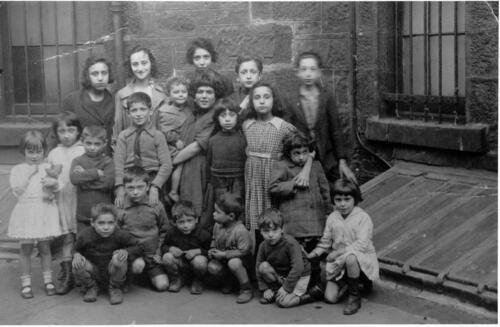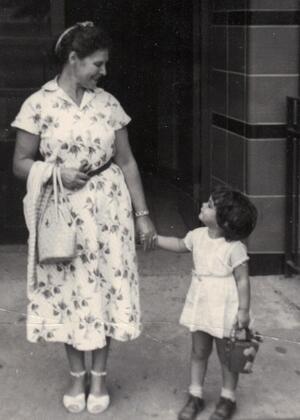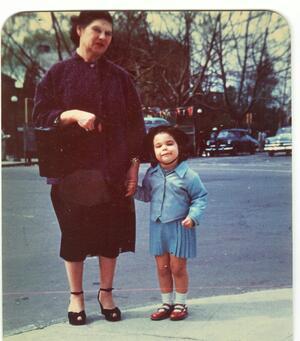“Can We Throw the Skirt Out?” A First-Generation Story
I am first generation American, as were most children and, for that matter, many of the teachers, in our public school. Not coincidentally, the word perseverance appeared often on our vocabulary lists. We used it in sentences, like “If you don’t have perseverance, you will not amount to much”—but I already knew that before I started kindergarten. Perseverance was my Aunt Jennie’s word of the day, every day.
Jennie was the oldest of eleven children growing up in the Gorbals slums of Glasgow, Scotland; my father was ninth. Teeming with waves of Jewish, Irish and Italian immigrants, the conditions in the Gorbals were such that there had been an outbreak of bubonic plague to which the Glasgow government responded by sending out large numbers of rat-catchers.
Jennie had no birth certificate. When she found she was the last one of her friends not attending school, she walked over and enrolled herself in Glasgow’s public kindergarten, against her mother’s wish to keep her home to help with the housework and babies. Jennie was able to stay in school until she was thirteen, when her father, a tailor, lied about her age and pulled her out to work as a seamstress. She eventually found a boyfriend, but her mother warned her, “You’ll marry him, you won’t have bread to eat”—not an abstract prediction.

Children in a courtyard in the Gorbals, Glasgow, by an unknown photographer. The author's father Sam is the little one in the front looking to the side, her uncle Ben is in the first row, far left and third from left is her uncle Harry. Fay stands at the center of the photograph holding Max, who died at age eight in America.
Jennie left for America, where the streets were paved with gold, when she was nineteen. She travelled steerage; the ship’s manifest shows she declared twenty-eight dollars. She worked as a seamstress, saved and sent for her father and her oldest sister, Sadie because they could work. It took two years to send for the rest of the family.
My father was seven years old when he arrived. The ship’s manifest shows that he and his eight brothers and sisters arrived with no money. They also arrived with no mother. The U.S. Immigration Act of 1924 designed to stop the wave of Jewish immigration had recently been signed into law, and it closed off Russian immigration. My grandmother was not a Scottish citizen; she was Russian. She put her children on the boat, leaving Fay, who was sixteen, responsible for eight children, the youngest of whom, Ethel, was two, to travel for a week, steerage, to live in a foreign country with a father and two older sisters that some of them barely remembered.
When they arrived, Fay had to run the household. Jennie was frantic. She tried to bring Ethel back to Scotland, because, as “the baby” she needed the most attention, but her mother wanted Ethel in America, in case the law changed again to exclude all Jews.
Jennie heard there was a Congressman who helped Jewish immigrants and she went to see him. Sol Bloom became very interested in her case, and over the course of three years, he was able to bring their mother over. My father was ten years old when he finally lined up, with his brothers and sisters, in the living room to re-acquaint themselves with their mother. She stood there, counting her children, and then turned to ask Jennie where Max, who would have been eight, was. He had died two weeks earlier, of untreated rheumatic fever. To lessen the shock, Jennie told her he was in a hospital, and then, a few days later, told her he had died.
Twenty-five years later, after Jennie’s son was grown and moved away, she came over almost every afternoon to see me, her “kid brother’s wee bonnie lassie.” Usually she read to me, or took me to the playground. Occasionally we went on excursions, once to the Museum of Natural History; once, around the corner, to Our Lady of Lourdes Grotto. I had been warned never to go in there, that if they caught a Jewish child in there, they killed them. Jennie responded that if they found out we were Jewish they would probably be very pleased we were interested in learning about their religion.
Sometimes, Jennie took me along to her favorite fabric store, a few blocks north of the Grotto. Jennie had long ago stopped working as a seamstress, but she maintained a small sewing station in her bedroom and made clothes for herself and the family. She made a plaid jumper for me when they were all the rage. Even then, I could tell it was better quality than clothes pulled off the rack, elegantly longer, with more sophisticated muted colors. I felt the grade school equivalent of ‘dressed for success’ when I wore it.
Jennie thought that little Bronx store had the best fabrics, better than in the garment district. So did Madame Chiang Kai-Shek. Describing her as the President of China’s wife, Jennie told me about meeting her there from time to time and that she knew a lot about the qualities of Chinese silks and was very interested to learn about British Isles wools. It was an ordinary conversation, except that it could only have taken place—for either one of them—in America.
Sooner or later, during every visit, Jennie would talk about Scotland, and then I was crossing the Lowlands instead of Pelham Parkway with her. I could see her running to put a pillow under her skirt to play dress-up as her mother. I was walking to school with her through Scottish rain, being greeted by passers-by who tipped their hats saying, “Fine weather for the ducks, Miss!” I was listening to the history teacher talking about Robert the Bruce, King of the Scots, who hid in a cave, after being defeated six times by the English. He stayed in the cave, six days, watching a spider trying to weave a web on rock. On the seventh day, on its seventh attempt it finally succeeded. King Robert took the lesson, and won his seventh battle.
Jennie was passing me this mantle, embroidered with stories, and I took it.
I never learned to sew, but I can distinguish the quality in unaffordable clothing. My best thrift shop find ever was a designer soft white skirt with a large white decorative button on the waistband. Jennie would have loved it. I spilled tea on it the first day I wore it. It did not bleach out; it turned yellow. I brought it to the cleaner, who took the skirt home to soak it in some solvents and then hang it to dry in the sun, and see if that might work. It didn’t.
“Let’s dye it black,” I suggested. He cautioned that the dye would work differently on the stained area, but I persisted. A few days later, I had a cloudy black skirt, with a greyish blob where the stain had been. The threads, which had been colorfast, remained white. He presented it, with an air of finality, which I ignored.
“Okay,” I said, “let’s try a tie-dyed look, and add a few colors.”
He leaned over the counter, waited to establish solid eye contact, and said, “It won’t work. Can we throw the skirt out?”
“Can we what?”
“Can we throw the skirt out?”
This didn’t seem like something Aunt Jennie would do, but since this tailor had done everything short of performing incantations over the skirt, there was nothing to do and that, I thought, was the end of that.
But later, when I was practicing a particularly difficult piece of music to use professionally, and getting nowhere with it, I heard the tailor’s voice in my head asking, Can we throw the skirt out? I looked at the sheet music. Can I? Can I throw it out, instead of engaging in six battles with this piece that is clearly beyond my technique? What would Jennie say? Or could I throw that out, too?
I was a child when I unquestioningly took on Jennie’s try, try again philosophy as my own. I was a grown woman now; it was high time I thought things through for myself. Jennie lived through a time and place where if she managed to get her hands on some fabric, and she made a mistake, she did not get a second chance. But I didn’t grow up in the Gorbals, or even in her America, because she fought that battle for me. I grew up in the America Jennie ultimately succeeded in delivering—where you could run into Mme. Chiang Kai-Shek shopping for silks, where if you made a mistake, you could go back and buy another yard. I needed to tailor Jennie’s mantle to fit me; to let out the seams a little so I could breathe.
I think Jennie hoped that by passing on her stories, later generations would be able to judge whether the struggle of coming to America had been the right choice. Had she done the right thing by bringing her family over from Scotland? Was the suffering worth it? No distant generation will ever be able to answer that question, and I wish she could have come to terms with that and let it be.
What I do know is that everyone who goes, like everyone who stays, assumes unknowable risks. For my part, I think if it weren’t for Jennie, I’d be sitting in a factory somewhere, watching spiders spinning webs. I thank you, Aunt Jennie, for bringing the family to America where every once in a while, you can just throw the skirt out.








What a fascinating family history! I never even heard of the Gorbals slums of Glasgow nor of there being a Jewish community there. Thank you, Lauren, for sharing this with us.